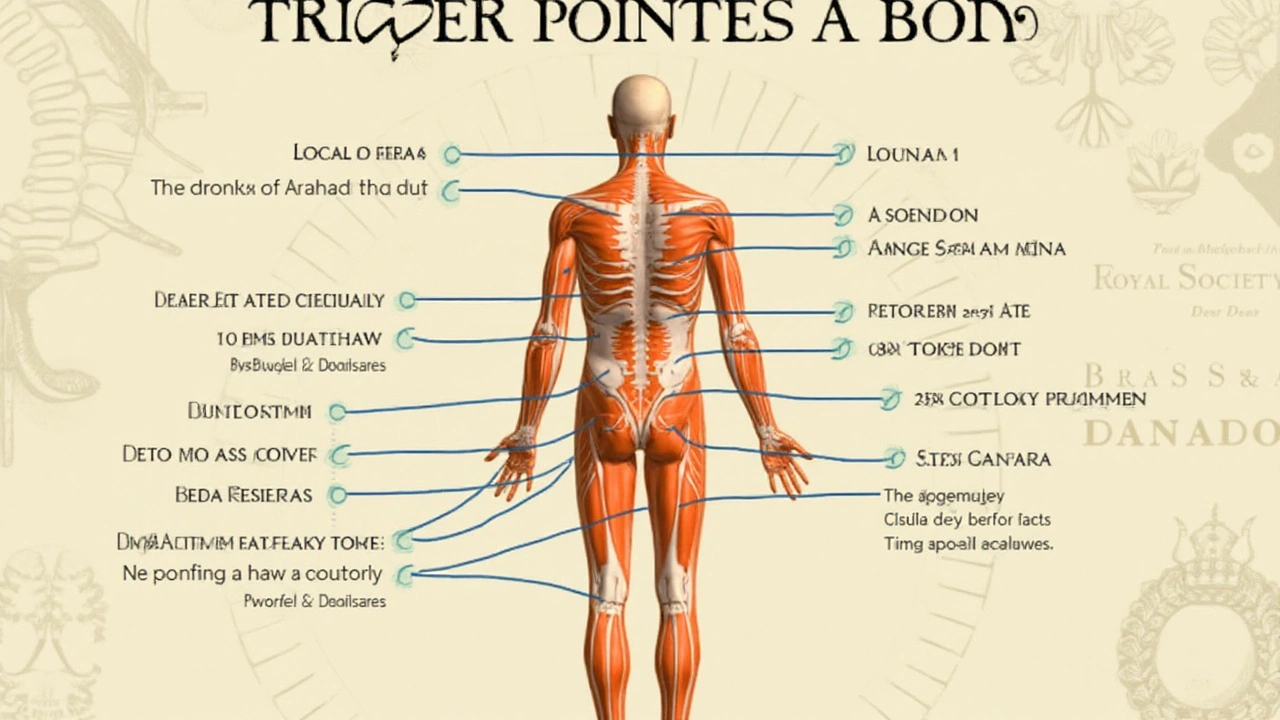Unlocking the Secrets of Trigger Point Massage Therapy

Trigger point massage is a specialized technique that targets specific areas in your muscles known for causing discomfort and pain. These trigger points can sometimes be felt as distinct knots under the skin and might send pain to other parts of your body, adding a mysterious layer to the pain puzzle. When pressure is applied correctly to these spots, it can lead to significant relief.
Originating from the study of myofascial pain syndrome, this practice is rooted in the belief that certain muscle groups can host spots of tension that cause both local and referred pain. The goal of this massage type is not only to relieve the pain localized at the trigger point but also to enhance overall well-being by boosting circulation and easing muscle tension.
Intriguingly, the success of this therapy isn’t just confined to muscle relaxation. Many have reported a general sense of improved mood and health following sessions, making it a sought-after therapy for a range of individuals looking for both physical and emotional comfort. Understanding how trigger point massage works can empower you to make informed decisions about your health choices.
- Understanding Trigger Points
- Science Behind the Therapy
- Benefits of Trigger Point Massage
- Techniques Used by Professionals
- Common Myths and Misconceptions
- Tips for Finding the Right Therapist
Understanding Trigger Points
In the realm of muscle therapy, trigger points are unique players. They're spots found in skeletal muscles, feeling like small knots and are incredibly tender when touched. These points are notorious for causing not only direct pain but also referred pain, where pain is perceived in a different location from the actual site. Understanding these nodes requires delving into why they occur and how they are connected to broader muscle dysfunctions. This refers to areas in the muscle fibers where tension can accumulate due to various factors like stress, overuse, or injury, leading to both discomfort and restricted movement.
The science behind trigger points suggests they result from a compromised blood supply to specific muscles, thus affecting their proper function. When blood flow is restricted, it limits nutrient delivery and waste removal, which then contributes to the formation of these hard and sensitive spots. This phenomenon can interrupt neural communication and lead to a cycle of pain and dysfunction in the muscle. The presence of multiple points in one muscle often gives rise to complex pain patterns making treatment intuitive rather than formulaic.
The Anatomy of a Trigger Point
Through research, it's been found that trigger points harbor high levels of inflammatory agents and neuropeptides due to the lack of oxygen and nutrient delivery. These chemicals can disrupt normal electrical activity in the muscle, resulting in what feels like a 'knot'. It's worth noting that not all muscle knots are trigger points – true trigger points refer pain to other areas of the body, which is a specific diagnostic feature. Another interesting aspect is the muscle's sensitivity, which varies, thereby influencing how the pain presents and how a person perceives it. Muscles strained by sudden impacts or those exposed to repetitive motion are frequent hosts to trigger points.
While examining this perplexing topic, Dr. Janet Travell, a renowned figure in this field, noted, "Knowledge of trigger points gives a refreshing shift in understanding chronic pain, offering solutions that bypass traditional approaches."
"Trigger point therapy's effectiveness lies in its ability to address deep-seated muscle groups directly and efficiently," states a prominent discussion by the Mayo Clinic on current alternative pain relief methods.As these insights illustrate, handling trigger points asks for a foundational understanding of muscle mechanics coupled with practicing targeted treatment techniques. Such knowledge equips massage therapists with the right skills to address pain and discomfort among individuals experiencing myofascial issues. The complexities tied to these points demand a detailed and empathetic approach for effective relief and long-term solutions.
Science Behind the Therapy
The concept of trigger point massage is deeply rooted in the study of myofascial pain, a field that examines the pain and discomfort arising from the muscles and connective tissues. These trigger points are often related to nodules in taut bands of muscle fibers and can be tender to touch. When these points are active, they are known to cause pain not only in their immediate vicinity but in other parts of the body as well. This is referred to as referred pain, a phenomenon that intrigued scientists and therapists alike. Research into these points has revealed that their existence is linked to a variety of factors including stress, repetitive muscle strain, and, at times, trauma.
It was the pioneering work of Dr. Janet Travell, the renowned American physician, that truly brought recognition to the field of trigger point therapy. She strongly advocated for the treatment of trigger points as a means to alleviate chronic pain symptoms in patients. Her studies suggested that addressing these specific loci in the muscular network could significantly reduce pain sensations and improve patient mobility. The therapy capitalizes on the principle that consistent pressure on these painful knots can 'deactivate' them, reducing the electrical activity associated with pain cycles. This process not only helps in loosening these muscle fibers but also restores healthy function.
To break down how this method functions, consider the microscopic muscle fibers like tangled cords. Imagine applying pressure using specific techniques much like untangling a messy bundle. The pressure facilitates an increase in local circulation, delivering an essential boost in nutrients and oxygen, while simultaneously flushing out lactic acid and toxins that have built up. The relaxation response induced by this targeted therapy helps in easing anxiety and promoting overall well-being. One study published in the Journal of Physiological and Behavioral Science noted a 30% faster recovery in patients undergoing trigger point therapy compared to those who only relied on medications.
"Trigger point massage not only addresses localized pain but serves as a bridge toward comprehensive recovery by addressing deeper layers of muscular tension," states Dr. Mary Sanderson, a notable author in the field of therapeutic bodywork.
This technique's intricacies lie in the precision of identifying trigger points and administering the right amount of pressure without injuring the muscle tissue. Licensed therapists undergo extensive training to hone this skill. While many people might assume a little pressure is enough, the reality is that trigger points require a specific combination of pressure point holding, stretching, and soft tissue manipulation to reach their full therapeutic potential. The art and science of this therapy converge to empower therapists and benefit patient care vastly.
In understanding how trigger point massage therapy works, it's key to recognize that it's not a one-size-fits-all approach. Each individual's experiences and muscular texture, tone, and elasticity will inform how a session is tailored. This personalized approach allows for adjustments based on sensitivity levels, target areas, and desired outcomes. Those who regularly engage in physical activities or have a desk-bound lifestyle are known to have increased occurrences of trigger points, thus benefiting greatly from regular therapy sessions designed to relieve muscle stress and tension.

Benefits of Trigger Point Massage
Exploring the benefits of trigger point massage opens up a world of potential relief and increased wellness. People who suffer from chronic muscle tension or pain are often surprised at how targeting specific trigger points can alleviate soreness. Regular sessions can help break up the persistent muscle knots that contribute to long-term discomfort. This form of massage works at the root level, ensuring that the relief experienced is both immediate and lasting. For many, it's a journey towards reduced pain and improved function.
One of the remarkable benefits of this technique is its ability to enhance blood circulation. When a therapist applies pressure to trigger points, it encourages better blood flow, which is crucial for healing and delivering nutrients to injured tissues. Improved circulation means that oxygen reaches muscle fibers more efficiently, aiding faster recovery and reducing the risk of injuries. Consistent treatments can therefore play a vital role in both preventive care and recovery protocols for athletes and active individuals.
Stress reduction is another valuable advantage of trigger point therapy. By alleviating tension in the muscles, many people feel a profound sense of relaxation that extends beyond the session. This kind of massage supports mental well-being too, contributing to an overall uplifted mood. In a world where stress is an everyday companion, finding methods to combat it can greatly impact one's life quality. Speaking on the importance of relaxation in health, renowned physiotherapist John Smith notes, "Muscle relaxation contributes not only to physical ease but also to mental clarity and better emotional balance."
Muscle relaxation contributes not only to physical ease but also to mental clarity and better emotional balance – John Smith, Physiotherapist.
Trigger point massage also helps in increasing flexibility and mobility. With the breaking down of adhesions and tension in muscles, individuals often regain a wider range of motion that was previously restricted. This is particularly beneficial for older adults or those recovering from surgeries where regaining movement is crucial to independence and daily function. By engaging clients in a consistent routine of sessions, it’s possible to see notable improvements in how the body moves and responds to physical challenges.
Lastly, regular appointments can strengthen the immune system. While this might seem indirect, the way massage reduces stress and enhances circulation contributes positively to immunity. Less tension and better circulation mean the body can allocate more resources to protecting and repairing itself. An unexpected benefit to many, these sessions are more than just muscle relief—they're an investment in a healthier future. Research supports that a relaxed body with optimal blood flow has a heightened ability to fend off diseases and recover from them more efficiently.
Techniques Used by Professionals
In the world of trigger point massage, the techniques employed by skilled therapists have a direct impact on the success of this therapy. These techniques are designed to target and alleviate the discomfort associated with trigger points, which are often described as hyper-irritable spots within the tight muscle bands. Professionals are trained to identify these spots by feeling for small, taut areas in the muscle tissue. They employ a wide array of methods to relieve tension and restore normal function to the affected muscle area. An essential technique is the application of sustained pressure using the fingers, knuckles, or elbows to the trigger point. This pressure helps to deactivate the point, breaking the pain cycle and promoting better blood flow. Therapists might adjust the amount of pressure based on the individual's tolerance and response during treatment.
Another common approach is known as the 'ischemic compression' technique, which involves applying direct, deep pressure to a trigger point until the discomfort dissipates. This method temporarily reduces blood flow to the stressed area, followed by an influx of blood flow once the pressure is released, helping to flush toxins and promote healing. In some cases, therapists integrate stretching of the affected muscle after applying pressure, enhancing flexibility and further reducing muscle tension. Soft tissue manipulation may also be used, designed to relax muscles and increase elasticity in the surrounding tissues. This type of massage is not only about releasing the tension but also about educating clients on how to avoid chronic pain in the future.
Additionally, many professionals employ techniques such as 'muscle energy technique' (MET), where the client actively contracts their muscle against a therapist-provided resistance. This method helps to improve the length and strength of the muscle, aiding in trigger point release. An intriguing statistic from the American Massage Therapy Association suggests that over 72% of clients have reported significant improvement in pain symptoms following trigger point therapy.
According to Dr. Janet Travell, a pioneer in the field, 'Freedom from pain is the single most important thing that triggers can provide to the body. Identifying and releasing them can change our quality of life.'In some sessions, therapists may also employ contrast therapy, alternating between hot and cold treatments to relax the muscles further and promote healing, particularly effective for those who might have experienced sports-related injuries.
Clients can also be taught self-care techniques, empowering them to maintain muscle health between professional sessions. Using tools like foam rollers or massage balls allows individuals to apply targeted pressure to their trigger points at home. Professionals guide clients on proper usage, ensuring no harm is done while still achieving effective results. The continuous development of these techniques keeps the practice of trigger point massage dynamic, and therapists often share knowledge within their professional communities to improve outcomes for their clients continually. With a growing interest in natural and non-invasive treatments, the role of a well-trained therapist in managing pain and improving mobility through massage therapy is increasingly vital.

Common Myths and Misconceptions
In the vast world of therapy, trigger point massage often stirs quite a few myths that need unpacking. One popular misconception is that this massage is only for athletes. While it is true that sports enthusiasts frequently seek this therapy for muscle recovery, that's not its sole audience. Everyday individuals experiencing muscle tension or chronic pain could also benefit significantly from it. Interestingly, many people are surprised to learn that trigger point massage isn't about deep, painful pressure. It's about finding a balance of pressure that provides relief without hurting the recipient.
Another intriguing myth is that trigger points are easy to locate and treat, almost like magic buttons. In reality, pinpointing these troublesome spots requires a skilled touch and substantial anatomical knowledge. This is why it takes a trained therapist to effectively address them. There's also the wrong notion that once these points are pressed, they vanish forever. The truth is that addressing trigger points is part of a larger ongoing approach to body care, and not just a one-time fix. A holistic regimen involving regular treatments, stretching, and adequate hydration helps keep the muscle knots at bay.
Many people also believe that these techniques are a new-age fad with no scientific backing. This couldn't be farther from the truth. Unlike old wives' tales, the practice of trigger point massage is supported by both research and the positive experiences of countless recipients. An article in a renowned medical journal mentioned,
Techniques addressing myofascial trigger points are well-founded in science and offer notable relief for chronic pain sufferers.This coaxes even the most sceptical minds to give such therapies a try.
A final common myth is that the effectiveness of these massages varies greatly among individuals. However, while personal experiences do range, the broad consensus is that anyone with muscular discomfort can achieve some measure of benefit. Remember, the journey to wellness is personal and subjective. Though results can sometimes be subtle or gradual, it’s valuable to approach trigger point massage with patience and consistency, as these practices aim to promote relaxation and well-being in the long run.
Tips for Finding the Right Therapist
When it comes to embracing the relief and rejuvenation offered by trigger point massage, selecting the right therapist can make all the difference. With a variety of practices and specialties out there, diving into the world of massage therapy might seem daunting. But worry not! Here are some tried-and-true tips for navigating this vital decision, ensuring you find a therapist who not only understands your needs but also has the expertise to follow through.
Firstly, consider their qualifications and training. A reputable therapist will often be certified by a recognized national or international body. This certification ensures they have undergone rigorous training and are well-versed in the anatomy of trigger points along with effective techniques for relief. Verifying their credentials through an online registry can offer peace of mind. In Australia, the Massage & Myotherapy Australia association is a good start. Membership typically requires adherence to certain professional standards and ethics.
Next, delve into their specialization. While many therapists are proficient in different forms of massage, finding one specializing in trigger point therapy can lead to better results. Specialization often means the therapist has focused training and experience addressing specific muscle tensions and can provide a more targeted approach.
“A therapist with specialized training can significantly enhance the benefits you gain from treatments, ensuring more precise and effective therapy sessions,” notes a study from the Journal of Bodywork & Movement Therapies.
Word-of-mouth recommendations can also serve as a reliable guide. Friends, family, or even online community forums might have valuable insights about local therapists. Additionally, checking online reviews provides a glimpse into other clients’ experiences. A therapist with a slew of positive reviews often highlights their dedication to client satisfaction and effective treatment methods. Keep an eye out for remarks about their ability to listen, customize treatments, and provide a calming environment.
Compatibility plays a crucial role too. Scheduling a preliminary consultation can be a wise move. This initial meeting allows you to discuss your specific concerns, ask questions about their approach, and gauge whether their communication style meshes well with your preferences. Often, the therapist’s demeanor during this meeting can hint at what to expect during actual sessions and whether you feel at ease with them.
Lastly, consider their availability and location. Consistency matters when it comes to massage therapy. Ensuring the therapist's schedule aligns with yours can eliminate any potential stress surrounding treatment visits. Moreover, choosing a therapist whose location is convenient can aid in sticking to a regular treatment regimen, enhancing the therapy benefits you receive. Regular sessions help maintain muscle health and prevent pain from reoccurring.





